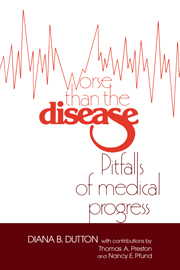Book contents
- Frontmatter
- Contents
- List of contributors
- Preface
- Acknowledgements
- List of abbreviations
- Part I Overview
- Part II Four case studies
- Part III Lessons, questions, and challenges
- 7 Risks and rights
- 8 Compensating the injuries of medical innovation
- 9 What is fair? Medical innovation and justice
- 10 The role of the public
- 11 What is possible? Toward medical progress in the public interest
- Notes
- Index
7 - Risks and rights
Published online by Cambridge University Press: 05 May 2010
- Frontmatter
- Contents
- List of contributors
- Preface
- Acknowledgements
- List of abbreviations
- Part I Overview
- Part II Four case studies
- Part III Lessons, questions, and challenges
- 7 Risks and rights
- 8 Compensating the injuries of medical innovation
- 9 What is fair? Medical innovation and justice
- 10 The role of the public
- 11 What is possible? Toward medical progress in the public interest
- Notes
- Index
Summary
At times, human ingenuity seems unable to control fully the forces it creates … with Hamlet, it is sometimes better “to bear those ills we have than fly to others that we know not of.”
– Chief Justice Burger, referring to arguments against patenting genetically engineered bacteria; Diamond v. Chakrabarty, 447 U.S. 303, 316 (1980)All medical advances involve risks. Nothing ventured, nothing gained, as the saying goes. But that does not mean all risks are worth taking, or that we would all make the same choices. In at least two of the four case studies, DES and swine flu (and some might add the artificial heart), the risks were definitely not worth running, a judgment some observers made at the time. The periodic public controversies over genetic engineering also underscore the wide differences in people's responses to, and even definitions of, risks.
This chapter looks at how we view risks in general and the risks of medical innovation in particular. What makes some risks “acceptable” and others not? Why are patients, like most of those who took DES, often not told about the uncertainties and hazards of treatments? More broadly, what is or reasonably could be done to protect individuals and society against the potential dangers of new medical and scientific technologies? In the picture that emerges, the central problem appears to be the lack of concern about possible hazards on the part of those making decisions on the one hand, and the lack of communication of either dangers or doubts to those at risk on the other. These failures explain much about why the warnings of scientific and lay critics in the four cases had so little impact and why even predicted problems were not avoided.
- Type
- Chapter
- Information
- Worse than the DiseasePitfalls of Medical Progress, pp. 229 - 254Publisher: Cambridge University PressPrint publication year: 1988

